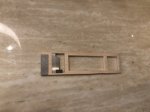I am planning on making our first ladder body car this year, so I wanted to experiment with a few things to prep for the build. Basically, I wanted to do a dry run and cut out a body to get one under my belt before it starts to count.
I read a lot of stuff on this site and elsewhere; I've watched a lot of videos online for tips. My plan was to use a cordless Dremel with a router attachment to cut out the body. This is a tool I'd never used before. (I'm sure some of you are smiling already.) At first I wasn't sure if I'd be able to freehand the tool to cut out the body. I did a couple of tests and the thing ran all over the place. I tried a few different bits and settings, but nothing helped. I knew there was no way I was going to be able to cut a straight line freehand. So there was no way my son was going to be able to do it. Freehand was out, so I decided I was going to make a fence to guide the tool. Spent several hours on it. Long story short, it was better, but still very imperfect. I'm still not sure exactly why. I usually have a pretty good eye and hand for precision work. There was easily up to 1/8" variance on my "straight" lines. The Dremel router was out.
Next experiment was with the scroll saw. Needless to say, that is the way to go. At least it was for me.
Anyway, for all of the experienced guys and pros, maybe it's worth a chuckle to imagine a relative rookie flailing about in his garage trying to figure out what works and what doesn't.
I read a lot of stuff on this site and elsewhere; I've watched a lot of videos online for tips. My plan was to use a cordless Dremel with a router attachment to cut out the body. This is a tool I'd never used before. (I'm sure some of you are smiling already.) At first I wasn't sure if I'd be able to freehand the tool to cut out the body. I did a couple of tests and the thing ran all over the place. I tried a few different bits and settings, but nothing helped. I knew there was no way I was going to be able to cut a straight line freehand. So there was no way my son was going to be able to do it. Freehand was out, so I decided I was going to make a fence to guide the tool. Spent several hours on it. Long story short, it was better, but still very imperfect. I'm still not sure exactly why. I usually have a pretty good eye and hand for precision work. There was easily up to 1/8" variance on my "straight" lines. The Dremel router was out.
Next experiment was with the scroll saw. Needless to say, that is the way to go. At least it was for me.
Anyway, for all of the experienced guys and pros, maybe it's worth a chuckle to imagine a relative rookie flailing about in his garage trying to figure out what works and what doesn't.

